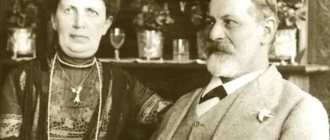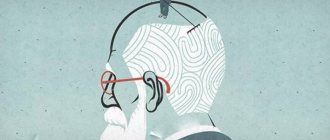Psychoanalysis and its effectiveness are confirmed by the research of biologists and the rich clinical practice of psychoanalysts. How does psychoanalysis work and where is the unconscious located?
Let's start with a clinical example.
The patient, a man, 44 years old, relates a dream at the end of the first year of psychoanalysis:
“I am standing at a well and looking down.
I know that there are five more people down there in the dark. I have a great feeling of guilt . The patient gave his own interpretation, with which the psychoanalyst agreed: “At the after-school program at school, besides me, there were five more people in the group and I was tormented by remorse that not much attention was paid to them because of me... Yes, I fantasize that Besides me, you have five more people and you have to spend a lot of energy on me, so there is little left for them.”
A couple of months later, the patient’s mother died and the grandmother told a terrible family secret: “After the patient was born, the mother had five abortions!” And this guilt of the mother due to abortions was unconsciously “transferred” to the patient and therefore he also began to feel guilty for their death, WITHOUT RECOGNIZING what actually happened , i.e. That is, the unconscious exists and influences us against our will!
Now let’s compare psychoanalysis and biology.
The cerebral cortex analyzes the surrounding reality and looks for those manifestations of it that you have already become acquainted with in the past, comparing them with each other.
The limbic system produces active biological substances - neurotransmitters, which are responsible for hormones. Neurotransmitters tell you: “This is good for you” or “This is bad for you, avoid it.” The body does not always follow the instructions of neurotransmitters, since the cerebral cortex can override it. The cortex rationally
analyzes information, and the limbic system motivates us to action.
The picture shows: the cerebral cortex receives the stimulus “A guy is telling me something on the phone”: and the limbic system unconsciously interprets this with feelings: “This is good” or “This is bad.” The developed
cerebral cortex distinguishes us from animals, thanks to it new ones are formed neural connections and pathways. However, the cerebral cortex sees around only a large number of unrelated details, and only the limbic system creates in us a sense of what is “good” and what is “bad” for us, by the fact that the neural connections that produce or joy hormones (dopamine, endorphin, oxytocin and serotonin) or stress hormones (such as cortisol). The cortex is our verbal thoughts, and the limbic system does not operate with words, so we feel unconsciously.
Neural pathways are shaped by our individual life journeys, which is why we respond differently to different events. Positive experiences create neural pathways that produce happiness hormones, and negative, traumatic experiences create neural pathways that produce stress hormones. And the person wants to avoid in the future the neural connections that were formed as a result of the injury. Example: A boy was praised for his performance in front of his parents.
. This formed positive neural pathways of “Getting up in public is a joy.” He can become a successful actor because these positive neural connections will be activated and constantly bring joy hormones. Of course, success is not only about “positive neural connections”, but also about hard work, talent and good life decisions with a bit of luck.
Another example, a father humiliated a girl
and this formed the neural connections “Relationships with a love object are stress, resentment, pain.”
Such a girl will avoid relationships with men in order to avoid prolonged activation of these neural connections. Patterns of negative relationships are constantly repeated in life due to the work of the limbic system and psyche - psychoanalysis calls this “transference” .
The cerebral cortex can “correct” old neural circuits! Psychoanalysis deals with this process! By reliving the traumatic experience in the office and interpreting it, negative neural connections change!
Sigmund Freud was the first to prove the influence of the unconscious on our lives.
Psychoanalysis arose at the dawn of the twentieth century thanks to the talent of the famous Austrian psychiatrist and psychologist Sigmund Freud, who proved that our consciousness is only a small part of personality. Our daily lives are powerfully influenced by the unconscious
- our secret drives and traumas tend to come out.
However, the unconscious is opposed by our mental censorship (parental and social prohibitions), and at the junction of this conflict all kinds of mental traumas, neuroses, phobias, etc. are born. Karina abandoned the child and went to the brothel, at the “order” of her unconscious.
And only in psychoanalysis did I understand this... An example of the influence of the unconscious on our lives. A successful businesswoman, Karina, began drinking after the birth of her daughter. Her tragedy was observed by all her friends, but they could not fix anything: after a while, Karina sent her daughter to an orphanage, and she herself went to live with a gay alcoholic. She lost her business, home and child. From the point of view of “simple life” it is difficult to explain, but the psychoanalytic solution to this grief of Karina lies in the fact that even in early childhood, her alcoholic mother sent her to an orphanage. Karina didn’t even remember her mother, but the events were firmly deposited in her unconscious. After the birth of a child, every mother relives her early problems and mental conflicts that have already existed in her life. Karina, after the birth of her daughter, again unconsciously experienced conflicts in the oral phase of her development (from birth to one year of age), when her mother drank, when Karina lacked her warmth and affection, when she was sent to an orphanage. And what happens: she, like her mother, abandoned her daughter and started drinking. Karina again felt an urgent need for maternal care and therefore found a substitute mother - a drinking woman of unconventional orientation. Fortunately, later Karina turned to a psychoanalyst for help and she began to get out of this problem: she had already left the woman, stopped drinking and would soon take her daughter from the shelter.
After the birth of a child, every mother relives her early problems and mental conflicts that were already in her life
Psychoanalysis is a personality-oriented method, i.e. its focus will be on the patient as a whole. In the process of psychoanalysis, self-awareness and self-understanding of the personal unconscious occurs - the keys to changing psychological attitudes, overcoming anxiety and fear. However, for psychological changes we need an object, i.e. a psychoanalyst onto whom we project our emotions - without this it is impossible to understand the deep aspects of our essence! This is why a heart-to-heart conversation with a friend will not replace psychotherapy, because... in an ordinary conversation, everyone listens to themselves, and only in a dyad with a psychoanalyst are healing transformations possible.
About treatment
Psychoanalysis is said to be a long-term treatment, usually lasting from two to five years. Let's start with the very concept of healing. To heal means to restore health, but healing also means leaving pain, getting rid of it. Diderot noted that if fever is cured with quinine, then literary fame is cured by lack of recognition, unfair preferences, enmity, envy, satires... Are we not trying, if psychoanalysis is banned, to escape its very essence? Psychoanalysis is in most cases opposed to medical therapy. What is its essence? Modern medical therapy subverts long-held ideas about healing by reducing healing to metron
, measurement and evaluation. This is an insight clinic focused on quantitative methods. At the center of therapy we always find the drug, which also modulates the effect; but the center of healing is always the patient and his quality of life, his health. For Hans-Georg Gadamer, for example, health is a matter of harmony, that is, balance and the right measure, elusive and incomprehensible.
The doctor is interested in the patient, as Lacan noted in 1966 in Psychoanalysis and Medicine, in order to make him sick. But he is also interested in him so that the patient confirms his disease, in order to identify the patient with his symptom. This has several advantages for the patient. The first is getting a new place in speech, supporting an unsuccessful speech, an erroneous statement. “Failure,” that is, illness, according to Gadamer, causes the subject to lose his place in the general discourse. But the return does not come without criticism of the healing.
Michel Foucault emphasizes that modern medicine strives not for individualized action, but for mass treatment
: The population is treated with the help of “healing machines”, hospitals and medical centers. The COVID-19 epidemic has shown the failure of states in mass medical interventions, and now, increasingly, at the heart of this machinery we find the patients themselves in the role of experts. In this case, the very reason behind the disease and the request for treatment is erased.
The body suffers, I suffer, everyone suffers
From a psychoanalytic perspective, the human body strives for homeostasis and health, for social aggregation/integration, just as it strives for self-enjoyment. It is a shimmering delight of language and speech. In the mid-1960s, Lacan, in the text already quoted here, emphasized that Freud invented psychoanalysis as a medical boundary in order to reveal the connection between the body as a biological machine and the enjoying body.
In general, for a clinician it is very similar to hand-to-hand combat. Enjoying himself - the body and his symptom, the subject is interested in the question of healing. Medicine feeds the modern subject's appetite for possible knowledge, speaks for the subject about what is wrong with him and why he is sick, sometimes even encroaching on knowledge of what the subjective meaning of his illness or symptom actually is.
If you are waiting for a standard prescription according to the ICD on how to cope with yourself in psychoanalysis, then this will not happen. Therefore, this is the first contraindication.
Illness has long been perceived as evil, morally evil. Diseases were stigmatized, patients were excluded from the society of “normal”, healthy people, a person’s illness was equal to his bad behavior, his ungodly thoughts... After the discovery of microbes, diseases received a material, objective embodiment. Hygiene and prevention appeared. A little later, the place of the microbial ontology of evil was taken by genes; in the mass consciousness, the causes of suffering and failure were now associated with the genome - science here is transformed into a religious belief in solving problems through the study of the genome and manipulations with it.
Thus, in the field of healing, the logic of the preventive and hygienic condition, the heir of epidemiology, as well as the logic of the market and the consumption of medicines, which now occupy a place in the cosmetic bag (with only one amendment - the cosmetic bag for health), are opposed to each other and connected with each other. Patients want a cure for their illness in the future more than right now. This race for health is an absurd caricature of the ironic “great health” that Nietzsche talks about in The Gay Science. We already have health, but the most important thing is to acquire it again and again. For Nietzsche, health is an imbalance, not a metrion; a balance that affirms not the prevention of disease, but the power of life in healing, beyond disease.
In my social circle
Actually, I started asking my friends what they thought about psychology in general. It turned out that among all my friends there is not a single supporter of CBT (!!!). I managed to convert 2 out of 4 acquaintances to CBT and now I have them, but at the time it seemed kind of crazy. I began to feel like a cultist of CBT, which works wonderfully in practice and allows me to improve my quality of life. I regularly took the Beck Depression Test and saw that mood can be measured numerically. I started practicing the exercises from David Bjorn's book Mood Therapy.
A clinically proven way to beat depression without pills . At that time, it had not yet been properly translated into Russian, and I read it in English, and did the exercises in English too, and it worked out great. I also developed an Android application to do these exercises on your smartphone and track them. I had 3 powerful CBT series for several months (end of 2021, beginning of 2021 and end of 2019). By the end of 2021, I managed to learn to live even better than my healthy friends. I measured their Depression Index and mine, which dropped to zero for a short period of time. True, if you don’t do them, then he usually returns to the level of mild depression, but still these exercises leave a powerful imprint on the mind and in some aspects “switch” the functioning of the brain.
The first cool advantage of CBT follows from this - you can practice it completely independently, and the entry threshold is not very high (although it was not familiar at first). With CBT, you quantify your mood (BDI test), and you can even graph it and watch your depression score drop. Research shows that CBT training can reduce moderate to mild depression in just a couple of months for the average patient (see graph at the very beginning of the book). This is exactly the schedule I got, and maybe even more favorable.
In the case of psychoanalysis, no average guarantees are given to you, and no measurements will be taken, indicators will not be tracked. A cunning psychoanalyst will tell you that you need to go for at least a year to achieve at least some results, and they will not be guaranteed even with such a duration. This is very convenient and profitable for a psychoanalyst, because you can siphon money from a patient for months for “analysis”, while the result of the work cannot be monitored or verified in any way. This creates ideal conditions for scammers. Analogues can be drawn with some state projects of strict secrecy, which are hidden precisely because there is nothing to show there except for cutting.
In 2021, one friend (whom I subsequently turned to CBT) also had problems with her mood and actively recommended me a psychoanalyst who is “good”, “nice”, “experienced” and “empathic”, and also charges 4,000 rubles per hour for an appointment . Even then I knew about CBT, but I decided to go to an appointment. At the appointment, I described my problems and said that I had heard about the scientific approach and measurements, about the dominance of CBT in Western medicine. I told him that I wanted him to analyze me according to the canons of psychoanalysis (or psychodynamics), and that I would test all the concepts and ideas that he puts forward by reading literature in English. And then he started to back up. This was my first and last psychoanalytic session.
Freud, the clinic and “analyzability”
Freud's psychoanalysis, as he himself notes, can
cure the symptoms of neurosis. Moreover, analytic experience can prevent the recurrence of symptoms and even allow a person to enjoy life - in work and love - but this does not at all mean happiness in his general understanding of happiness for everyone, for nothing and let no one leave offended...
But should the analysis apply to everyone? What about the fact that some subjects are, in analytical parlance, “unanalyzable”? A person who yearns for a cure in an analysis that goes far beyond mere symptom therapy (since the psychoanalyst, fortunately, does not prescribe drugs or tell you what to do), can undergo analysis with any satisfaction remaining beyond the horizon. This is what Freud called resistance. To heal someone suffering from neurosis from the point of view of psychoanalysis means to overcome resistance. And this interests Freud more than healing - what interferes with healing.
Might be interesting
Real death, symbolic conspiracy theories and an imaginary state. Psychoanalysis of a pandemic from Alexander Dugin and Jacques Lacan
Who is a psychoanalyst?
A psychoanalyst is a person who has a specialized psychological or medical education and has undergone additional retraining in this area. There are main ways to become a psychoanalyst: 1) Appropriate education and a certain amount of supervision; 2) Reading books on psychoanalysis (Freud and his followers); 3) Own analysis, and it is at least 250 hours. This is necessary in order not to shift your own problems onto the person.
Therefore, when choosing a specialist, ask where and how many hours he himself lay on the couch.
There is an interesting video where Professor M. Reshetnikov discusses the topic of modern psychoanalysis and what the work of a psychoanalyst consists of.
Refusal of the question
It is worth saying that the modern clinic of psychoanalysis is a clinic of pleasure and a clinic of transference, as Lacan and Freud understand it. Transference is the activation of the sexual reality of the unconscious, that is, in the request for analysis, in the request for healing, what is important is the subject’s desire to find out what is not going well in his relationship with the sex and himself and others. This is a question of enjoying yourself.
Consequently, psychoanalysis is contraindicated for those who do not ask themselves such a question. Alexandre Stevens, a lecturer at the Brussels clinical section and founder of the Curtil children's clinic in Brussels, describes a case of refusal of psychoanalysis to a man whose life was full. Except for one thing. All fifteen sessions during which he came, he complained about his wife. This is a serious dramatic story filled with physical suffering, this woman's suicide attempts, but he is denied analysis. They refuse because in order to change your symptom, you need to take the other one - your partner - into account and not waver in your desire.
The analyst is not a master, not a decision-maker, and not someone who practices with you as a coach; he is rather neutral in relation to your choice. As Lacan puts it, psychoanalysis cures ignorance but is powerless against nonsense. And if we are talking about contraindications, then psychoanalysis is not suitable for those who would like to enjoy their suffering. And that's his right.
Psychology as a subject at university
In 2021, I decided to try to study psychology in more detail and found the Canadian course “Introduction to Psychology” on the courser.
A very good and high-quality course, voluminous and at the same time interesting. I was wondering how psychology could be a “subject” at university. I completed the course in about a month and a half, and learned a lot, from clinical and cognitive psychology, to an introduction to neuroscience and the principles of memory. A very clear and precise picture of what psychology is was formed in my mind. I highly recommend this course because... he dots his i’s perfectly. As for psychoanalysis, it is only in the “History” chapter. Steve Jordan (lecturer) first introduces fundamental concepts of psychoanalysis that seem quite funny, like the anal-retaining and anally-pushing personality types or the Oedipus complex. Then Steve said a set of words that I will remember for the rest of my life:
As for the effectiveness of psychoanalysis, ANY therapy will be more effective than no therapy. Especially for patients with big wallets.
It turns out that there is no point in paying 3,000 rubles per hour for a “specialist” psychoanalyst.
You can just as effectively hire a supportive psychologist for less money, and you can also find people on Avito who are ready to communicate with you and support you in difficult times for a fairly modest amount. This is if you have no friends. The lecturer also noted that the basic concepts of psychoanalysis were taken by Freud out of thin air and by their nature we cannot experimentally test or prove them. It is very reminiscent of religion, when a certain set of postulates is given without proof and to be accepted on faith.
Is this all because sexual relationships don't exist?
In the above case, the suffering was centered around sexual, non-existent relationships - and the false satisfaction of the neurosis with transference love was for Freud the best proof that a human being is most hurt by his own sex.
For Lacan, transference serves as proof that love compensates for the absence of sexual relations. In psychoanalysis, the formula “absence of sexual relations” is understood as a question in place of any predetermined connection between the sexes. The trauma of sexuality is individual for each subject. There is no recipe for a happy love, relationship, life. Each of us invents his own way - the subject’s invention, in essence, is its symptom. And the symptom of psychoanalysis differs from the symptom in the medical clinic, since it is a constitutive feature of each, but nevertheless it can and does lead to suffering.
"Good" analyst
This, of course, does not discredit either transference or love, if we do not neglect the emptiness of meaning around what they themselves trigger (around non-relationships, lack of sexual connection). Resistance can also be the resistance of the psychoanalyst, especially if he is or wants to be an analyst who is good for his patient, a psychoanalyst who wants to be the right psychoanalyst, smart, the best, witty, graceful (underline as appropriate) - or, even worse, to be an excellent psychoanalyst for everyone, for example, for society, a country, a work group.
According to Freud, if the psychoanalyst does not heal, if the analysis remains an endless process, then most often this is due to the effect of the arrogance of the psychoanalyst who refuses to treat the other person.
Therefore, there is a desire to attribute cases of healing to God, the unconscious, another analyst - and in case of failure, this is also a reason to blame them all for the failure.
He refuses because...
Let us dwell in more detail on the figure of the psychoanalyst, and, ultimately, on his desire. We cannot talk about contraindications to psychoanalysis without taking into account the likelihood of error on the part of the psychoanalyst. If we look at the situation from the psychoanalyst's point of view, it is worth noting that the psychoanalyst is part of the symptom due to the fact that the speech, the symptom, is addressed to him, and we need to take into account that he must have some knowledge that will help decipher this symptom
.
On the part of the subject requesting the analysis, the subject's participation in his complaint is part of his symptom
. The immediate conclusion is that the assessment of contraindications to testing or the impact of testing on a symptom depends on what the person says about it. The so-called therapeutic effects of the test must first be assessed as possible indications or contraindications for the test.
Thus, the presence of reason and desire for analysis must be assessed in each case individually. The analyst, of course, may be tempted to take advantage of the weakness of the subjective position, doubts, but then this will be a false path, an intellectual deception, a trick and a concession to stupidity. A good analysis or a failed analysis always depends on the patient's agreement with methods and decisions individually specific to each clinical structure separately.
Is psychology a science or not?
And it depends on what language you are using.
The Russian word “psychology” carries a negative connotation and is usually associated with manipulation and deception, as well as trash books “about nothing.” And in the West, psychology is a full-fledged science based on mathematics (statistics), using an experimental approach and two dominant schools (behavioral and cognitive). Back in school, I began to think deeply about what was wrong with psychology. I had depression with a seasonal pattern, and I hoped to master psychology on my own and figure everything out on my own. I reflected a lot on my thoughts and noticed that if you think differently, you can successfully regulate your mood. You can also measure mood in numerical form (on a scale from 0 to 10), take measurements BEFORE and AFTER some activity, and then mathematically process these results and, based on average values, draw conclusions about the effectiveness of approaches. I invented something like primitive CBT, where every morning I go through a special piece of paper with questions, remember negative thoughts and reformulate them into positive ones. This was in 2013 and I remember how my quality of life increased. My goal is to someday learn English and find an area of psychology that has thought exercises.
If psychoanalysis does not cure, then what is the point?
As Lacan writes, in the practice of psychoanalysis, the psychoanalyst must beware of misusing the desire to heal. We find traces of this reflection in Lacan's early seminars, and the most radical formulation can be read in the seminar “The Ethics of Psychoanalysis.” The desire to be cured “by its nature leads us astray and knocks us down in the blink of an eye.” The desire to be cured can immediately make the situation worse. Lacan believes that it is better to “identify the psychoanalyst's desire as an unwillingness to treat.” The historical prerequisites for such a statement lie in the transformation of the theory of the psychoanalytic act.
Initially, psychoanalysis was based on speech, on symbolization, healing the subject by the very experience of free speaking and listening. Healing was understood as a journey towards a new meaning for a painful symptom. Later, in the Anxiety seminar, Lacan debunks his first argument by saying that healing is a side effect of analysis and introducing the dimension of error into experience. It is in a certain failure that the subject instantly finds the reality of his unconscious. In what follows, Lacan will replace the initial concern with healing the subject with the more subtle formulation of “improving the condition of the subject.”
And the next contraindication to analysis can be formulated as follows: the analyst does not provide the analysand with the opportunity to analyze, without being sure that he will provide him with a more advantageous position.
Not healing, but unwillingness
Since healing in general remains for Lacan an appearance and appearance, he proposes in analysis the path of not wanting to heal in order to avoid the impasse with the desire to heal, since it is implied that your illness and your suffering are your choice and a way of coping with the intolerable question of existence. This reluctance should not be confused with the desire not to be treated. The second occurs rather from the side of inaction and ignorance, the opposite of what the psychoanalytic act brings with it - the invention of new knowledge about oneself. This also echoes what Buddhism associates transitive desire, the desire for something in general, with suffering.
The path of reluctance is access to the awakening of another desire, when the material desire of this or that, in this case, a cure for an illness, serves us to lull the desire. Thus, the reluctance to be cured leaves room for this “treatment,” which psychoanalysis itself presents as access to the reality of the unconscious, a way to cope with the impasses of pleasure.
Not wanting to be cured is what comes closest to what Freud discovered: the analyzing subject is also one who doesn't want to be cured. In addition, life itself does not want to heal. The pleasure of the body does not want to disappear. However, the subject, the body, is always mistaken about the object of its suffering and pleasure because it is misled by the objects of desire. Objects of consumption deceive us: they do not cure us of the symptom of human pleasure. And, as we found out earlier, treatment in psychoanalysis is not the main experience. A symptom in psychoanalysis is not something that requires elimination, but something that answers the question of your existence as a person.
So, contraindications to psychoanalysis, like indications for it, depend, in essence, on the decision of the subject to come into analysis with suffering and honestly talk about it - its significant history, its suffering, its structure and its questions to itself will be the guides and methods . The experience of psychoanalysis is not for everyone, but it is possible for everyone if there is a desire to know the reason why you are who you are. Lacan’s famous formula – “everyone is delusional” – is precisely about this. Psychoanalysis is permission to own your own delirium.
How can you understand a person and thereby help him understand himself?
Psychoanalysis
is a method that helps a person understand himself.
This becomes possible due to the expansion of consciousness
, when previously inaccessible parts of the psyche become conscious.
Unconscious areas of the psyche are called the unconscious
.
The study of the unconscious is associated with immersion in depths, which is why psychoanalysis is also called depth psychology.
.
It may seem that only with the help of hypnosis is it possible to “look” into the depths of the psyche. But that's not true.
::
Psychoanalysis as a technique for treating neuroses appeared more than 100 years ago thanks to the cathartic method of Joseph Breuer
, who used hypnosis in his work (see
Talking therapy
).
Freud was a student of Breuer and also initially used hypnosis in his practice, but soon became disillusioned with it (see How hypnosis works
).
The day when Freud began treating his patient without resorting to hypnosis can be considered the birthday of psychoanalysis
(see
Prisoners of Conscience
).
Psychoanalysis
and
psychoanalytic psychotherapy
is always carried out with the patient (client) awake. Wakefulness is necessary because the psychoanalytic method involves the patient's active participation in the process of self-discovery.










